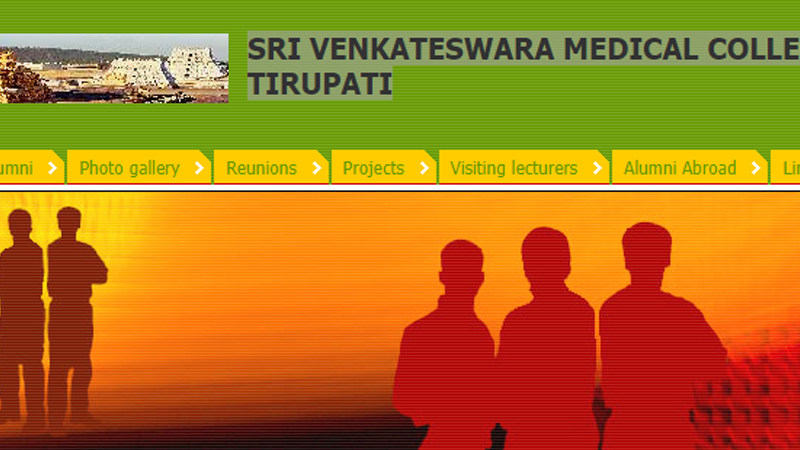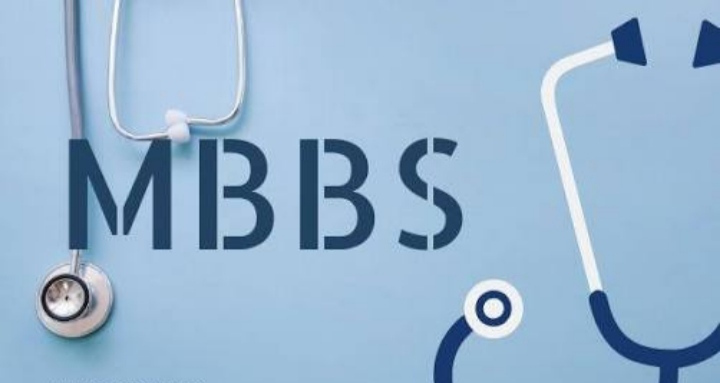
S V Medical College, Tirupati
I have created this site, mainly to provide a forum for the alumni of SVMC to get together on line with a view to develop an association in the future.
We can keep in touch, may be organise reunions and give something back to the college.
I will try and get some pictures and a list of alumni as soon as possible.
I am trying to organise a reunion of the 82 batch and would like to contct as many of my friends from the year as possible.
Please mail me with your contact details at venkat@svmedicalcollege.org
I am happy to co-ordinate any reunions of other batches.
All enquiries and help with building up this web site are welcome.
Diploma in Anaesthesia
एसवी मेडिकल कॉलेज, तिरुपती
Diploma in Dermatology, Venereology and Leprosy
Dermatology Venerology & Leprosy - DDVL is a PG Diploma course.
The programs intends to impart to the postgraduate student, professional competence in diagnosis and management of sexually transmitted diseases, common skin diseases, cosmetic dermatological diseases and leprosy independently. Graduant must independently be able to attend medical emergencies related to skin, venereal diseases and leprosy and adopt preventive measures at individual and community levels against communicable and non-communicable venereal diseases, skin diseases, leprosy and other such ailments. They should be qualified with skills to impart necessary knowledge and laboratory skills to other medical or paramedical faculties. They should also be able to observe the basic responsibilities and duties discharged unto him as a professional with compassion and sense of justice.
Curriculum : As per Medical Council of India (MCI)
Duration : Two years
Diploma in Ophthalmology
PG Diploma in Ophthalmology – DO is a PG Diploma course offered.
The Postgraduate Diploma in Ophthalmology builds on medical and surgical concepts learned in anatomy, physiology and ophthalmic diseases during the graduate degrees. Ophthalmology proposes to avert blindness, ascertain ocular health and rehabilitate patients with visual imparity. The program pertains to but is not limited to the study in ocular anatomy, physiology, optics, genetics, pathology, practical ophthalmic science. As demanded by most of the postgraduate diploma courses, they are expected to be capable of practicing at the secondary and tertiary level of the health care delivery system by the time of completion of the program. Postgraduate program generally demands self-directed study methodologies and necessitates gaining knowlegde emanating from clinical and academic work. Basic expertise in teaching and training the specialty are also essential.
Curriculum : As per Medical Council of India (MCI)
Duration : Two years
Diploma in Oto-Rhino-Laryngology
गुवाहाटी मेडिकल कॉलेज, गुवाहाटी
A Diploma in Oto-Rhino-Laryngology (ENT) is a specialized medical program that focuses on the diagnosis and treatment of disorders related to the ear, nose, throat, head, and neck. This diploma is typically pursued by medical professionals, such as doctors, who wish to specialize in Otolaryngology, commonly known as ENT (Ear, Nose, and Throat) medicine.
Here are some common components of a Diploma in Oto-Rhino-Laryngology program:
Otology: Study of disorders related to the ear, including hearing loss, infections, and disorders of the ear structure.
Rhinology: Examination of conditions affecting the nose and nasal passages, such as sinusitis, nasal polyps, and nasal obstruction.
Laryngology: Focus on disorders of the larynx (voice box) and the upper respiratory tract, including voice disorders and airway conditions.
Head and Neck Surgery: Training in surgical procedures related to the head and neck, including the removal of tumors, reconstructive surgery, and management of facial trauma.
Audiology: Introduction to the evaluation and management of hearing disorders, including the use of audiometric tests.
Speech and Swallowing Disorders: Study of disorders affecting speech and swallowing, including speech therapy and rehabilitation.
Pediatric Otolaryngology: Understanding and managing ear, nose, and throat disorders in children.
Facial Plastic and Reconstructive Surgery: Training in cosmetic and reconstructive surgery of the face and neck.
Allergy and Immunology: Addressing allergic conditions related to the ear, nose, and throat.
Research and Clinical Skills: Some programs may include a research component and practical training in clinical skills relevant to ENT medicine.
Completion of a Diploma in Oto-Rhino-Laryngology is often a prerequisite for becoming an ENT specialist or Otolaryngologist. ENT specialists may work in hospitals, clinics, or private practices, providing a range of services, including medical and surgical treatment for conditions such as hearing loss, sinusitis, tonsillitis, and voice disorders.
Otolaryngologists often collaborate with other medical specialists, such as neurologists, pulmonologists, and oncologists, to provide comprehensive care for patients with conditions affecting the head and neck. Additionally, some individuals may pursue further specialization within Otolaryngology, such as focusing on head and neck oncology, rhinology, or pediatric otolaryngology, through additional training and fellowships.
Diploma in Radio-Diagnosis
एसवी मेडिकल कॉलेज, तिरुपती
A Diploma in Radio-Diagnosis is a specialized program designed to provide education and training in the field of diagnostic radiology. Diagnostic radiology involves the use of medical imaging technologies to visualize and diagnose diseases and conditions. This diploma is typically geared toward healthcare professionals, such as radiographers or medical imaging technologists, who specialize in conducting and interpreting diagnostic imaging studies.
Here are some common components of a Diploma in Radio-Diagnosis program:
Radiographic Imaging Techniques: Training in the use of various imaging modalities, such as X-rays, computed tomography (CT), magnetic resonance imaging (MRI), ultrasound, and nuclear medicine.
Radiation Physics: Understanding the principles of radiation and its interaction with the human body in the context of diagnostic imaging.
Anatomy and Physiology: In-depth knowledge of human anatomy and physiology to facilitate the interpretation of medical images.
Radiographic Positioning and Techniques: Practical skills in positioning patients and operating imaging equipment to obtain high-quality diagnostic images.
Patient Care in Radiology: Communication skills, patient assessment, and care during diagnostic imaging procedures.
Radiation Safety and Protection: Practices to ensure the safety of patients, healthcare professionals, and the public during diagnostic imaging.
Contrast Media Studies: Training in the administration and interpretation of contrast agents for enhanced imaging studies.
Medical Imaging Equipment Maintenance: Basic understanding of the maintenance and quality control of diagnostic imaging equipment.
Ethics and Legal Considerations: Understanding ethical and legal aspects related to the practice of diagnostic radiology.
Clinical Internship/Practicum: Hands-on training in a clinical setting under supervision, where students can apply their knowledge and skills in real patient scenarios.
Upon completion of the program, individuals with a Diploma in Radio-Diagnosis are typically prepared to work as radiographers or diagnostic medical imaging technologists in hospitals, clinics, imaging centers, and other healthcare settings. They play a crucial role in the diagnostic process by producing high-quality images that aid healthcare providers in diagnosing and treating various medical conditions.
As with any educational program, it's important to ensure that the institution offering the diploma is accredited by relevant accrediting bodies or organizations in your region. Additionally, some individuals may choose to pursue further education, such as a Bachelor's or Master's degree, for career advancement or specialization in specific areas of diagnostic radiology
M.B.B.S.

Bachelor of Medicine, Bachelor of Surgery (Latin: Medicinae Baccalaureus, Baccalaureus Chirurgiae; abbreviated in many ways, most commonly MBBS, but also MB ChB, BMBS, MB BCh, MB BChir), is the primary medical degree awarded by medical schools in countries that follow the tradition of the United Kingdom. The historical degree nomenclature states that they are two separate undergraduate degrees. In practice, however, they are usually combined as one and conferred together, and may also be awarded at graduate-level medical schools.
Bachelor of Medicine and Bachelor of Surgery (MBBS), is a professional degree in medical science. A person holding the MBBS degree becomes a certified medical practitioner. The duration of MBBS course is five years and six months including one year of rotational internship at hospitals, health centres, and health camps organised by non-profit organisations (NGOs). MBBS course syllabus includes studies on anatomy, pharmacology, pathology as well as community health & medicine, paediatrics, and surgery. The syllabus, prescribed in such a way that MBBS degree holders can choose a specialisation for further majoring and practising medicine. The career specialisations for MBBS students are Nephrology, Cardiology, Gynecology, Anesthesiology, Organ Transplant, Endocrine, and General Surgery, etc.
MD - Anaesthesiology
The purpose of PG education is to create specialists who would provide high quality health care and advance the cause of science through research & training. A post graduate specialist having undergone the required training in anesthesiology should be able to recognize the health needs of the community. He or she should be competent to handle effectively medical problems and should be aware of the recent advances pertaining to his/her specialty. She/he should be highly competent anesthesiologist with broad range of skills that will enable him/her to practice anesthesiology independently. The PG student should also acquire the basic skills in teaching of medical/para-medical students. She/he is also expected to know the principles of research methodology and modes of consulting library. She/he should attend conferences, workshops and CMEs regularly to upgrade his/her knowledge. The purpose of this document is to provide teachers and learners illustrative guidelines to achieve defined outcomes through learning and assessment. This document was prepared by various subject-content specialists. The Reconciliation Board of the Academic Committee has attempted to render uniformity without compromise to purpose and content of the document. Compromise in purity of syntax has been made in order to preserve the purpose and content. This has necessitated retention of “domains of learning” under the heading “competencies”
MD - Bio-Chemistry
MD - Dermatology , Venereology & Leprosy
MD - Forensic Medicine/Forensic Medicine & Toxicology
MD - General Medicine
MD - Microbiology
MD - Pathology
MD - Pharmacology
MD - Physiology
MD - Psychiatry
M. D. in Psychiatry is a Clinical Speciality course.
Doctor of Medicine in Psychiatry explores the major psychiatric syndromes like psychotic, mood and anxiety disorders, psychological effects of physical diseases, the doctor-patient relationship, human development, patient interviewing, and ethical issues in medicine. It is a three-year postgraduation course and can be pursued by any MBBS holders from a University recognized by Medical council of India. Most psychiatrists practice general psychiatry. Sub-specialization in Child and Adolescent Psychiatry, Addiction Medicine, and Geriatric psychiatry can be conducted after M. D. in Psychiatry.
MD - Radio Diagnosis/Radiology
MD - Social & Preventive Medicine / Community Medicine
MD - Tuberculosis & Respiratory Diseases / Pulmonary Medicine
MD/MS - Anatomy
MD/MS - Obstetrics & Gynaecology
MD/MS - Ophthalmology
MS - ENT
MS - General Surgery
MS - Orthopaedics
- Log in to post comments
- 103 views
